Hey everyone! 😀 In our previous post, we talked about how light pollution affects marine life. However, do you know that we are also subjected to light pollution and it has also affected us in ways that we might not realise?
Circadian Rhythm
The Circadian Rhythm is present in all organisms and it serves to regulate our sleep-wake cycle every 24 hours and the disruption of this cycle through artificial light pollution at night (ALAN) would cause public health issues. For instance, artificial light from our laptops, smartphones, and lights in our houses are all mediums of light pollution.
Now, when the human eyes are exposed to ALAN it interferes with the body’s natural production of melatonin. This hormone is only produced by the brain’s pineal gland in response to the early morning hours of darkness (Patel, 2019). Studies have found that long term suppression of melatonin production by exposure of ALAN might put you at higher risks for breast and colorectal cancers (Pauley, 2004).

What Can We Do?
Today, we are exposed to more and more blue wavelengths and these can be found in our surrounding environment such as street lights. However, indoor lighting also plays an important role as the type of lights such as the ones containing blue wavelengths have been known to suppress melatonin production more than other colours (Pauley, 2004).
It is recommended that indoor lighting be dim and use lights with yellow and orange wavelengths. Using less fluorescent lights will also reduce the amount of exposure to blue wavelengths. Moreover, it is also good to be in a room of complete darkness during your sleep. With these interventions, I hope you are able to lower your exposure to ALAN. 😀
References
Pauley, S.M. (2004), “Lighting for the human circadian clock: recent research indicates that lighting has become a public health issue”, Medical hypotheses, vol. 63, no. 4, pp. 588-596.
Patel, P.C. (2019), “Light pollution and insufficient sleep: Evidence from the United States”, American journal of human biology, vol. 31, no. 6, pp. e23300-n/a.
